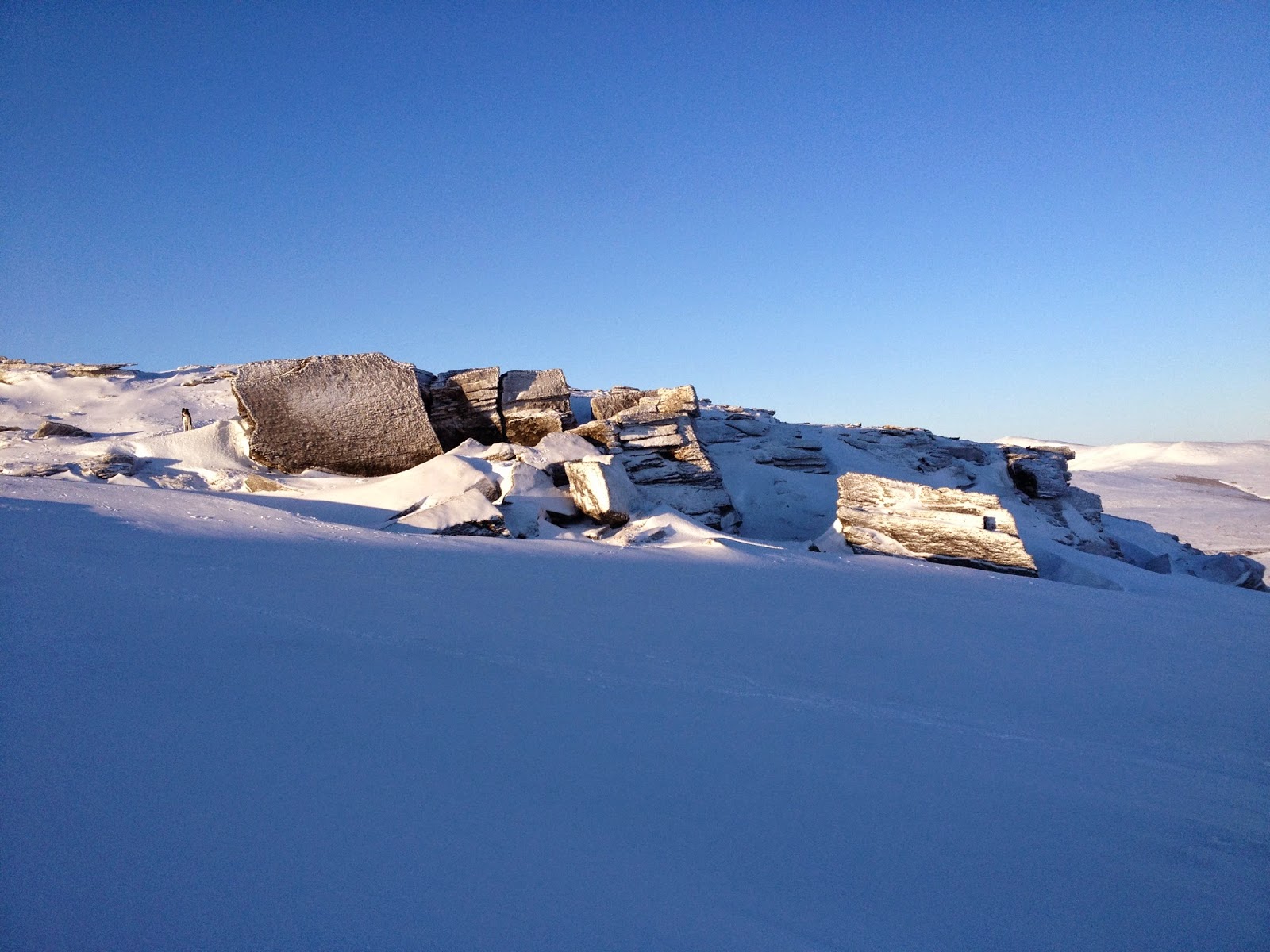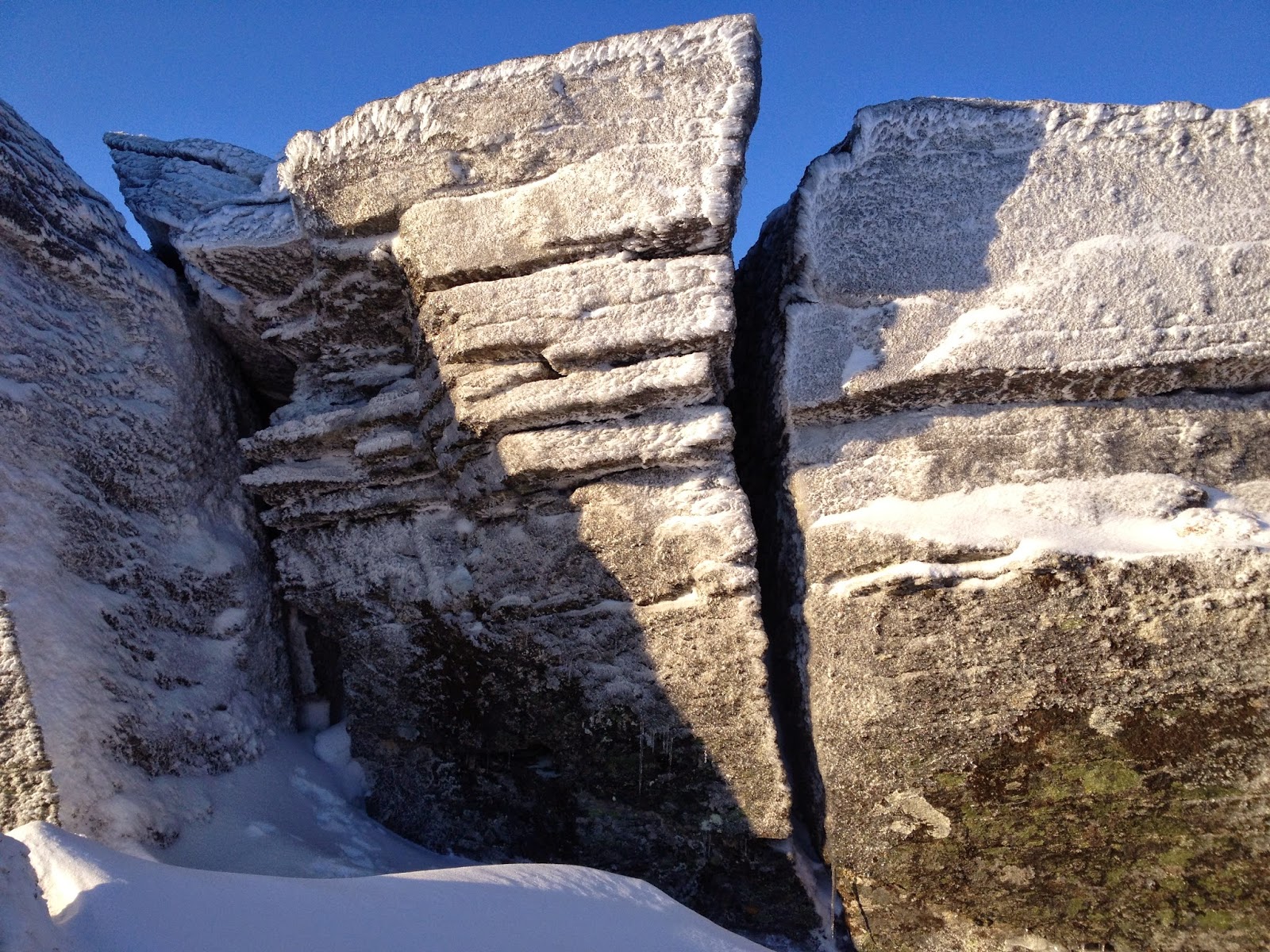But starkly placed on the east shoulder of Anvil Mountain within easy reach of Nome, the rock transforms into a destination bouldering Zen-garden, an ever-shifting funhouse of iced-up planes of textured rock. In previous winters, the White Alice Rocks were sealed over under the snow-- in other words, nonexistent. In summer, these rocks offer little more than worthless crumbles. But last winter, the shockingly low-snow year of 2014, the seal of snow pulled back like a bubble bursting revealing a tiny ingrown wonderland of climbing joy, a sweet little mixed-bouldering area, freshly decanted and never-before dry-tooled, only a 5-minute drive from town, a short hike up Bear Creek on a northwest tack from the little skier parking lot at Newton Peak, the end of the road spot in wintertime on the Dexter Bypass Road.
(above) Lucy in wind with White Alice towers in background, on one of our many visits to the White Alice Rocks this previous winter. The towers were tropospheric scatter antennae for microwave radio waves. Many a thrill-seeking Nomen made the hideous, toxic, carcinogenic climb up the sixty foot towers via a curved internal scaffolding made of I-beam girders. A
Ground cornices of drifted snow form troughs at the very base of the rocks, wavy, perfect luge runs on which Lucy banks her turns at full speed for the sheer joy of it, while I boulder just above on overhanging rock, laying back on the tools which are hooked on schist, with the curve of the snow in the trough matching the curve of my back, the snow bank making a natural, ergonomic spotting device.
Between pump-outs in the blowing spindrift, huddle between the rocks, lost and forgotten above the town. Stare at the surface of the rock. Graupels of snow collect on the catchment systems of lichen clinging to the wall. Rime crystals of ice stand up on the rock like columns. High-frequency whistling noises issue from a hole in the rock eight feet to your left. Bored and getting cold now, simply reach up above your head, hook a tool, and resume the workout again with a one-arm pull-up. Off you go.
Information conveyed in the skeins of snow filagreed across the hardpack like a neural network. The tiny bump on the shoulder of Anvil Mt. welcomes you back, glad to see you again, politely asks you how your time was in town, and what brings you back, a little bouldering perhaps? You have completely enlivened the winter for this slight conclivity of rocks and tundra. What otherwise would have been highly inanimate has been rendered more animate by your bouldering visitations.
(above) A decent dry-tool circuit may be successfully devised at White Alice.
Let this be the official Pee Mark: MARK! I hereby lift my leg upon the White Alice Rocks by categorically stating that if it's an obvious problem of M6 difficulty or less at this area, I probably climbed it during the Winter of 2014. I climbed 56 boulder problems in 14 trips to the rocks, and named each one with a super-groovy title translated into Inupiaq, and attached specific ratings in a variety of global rating systems to each problem, and indexed all the problems in a color-coded grid system which I have submitted to Kigsblog for publication. And here we see the true, hidden intent of the blog: to relieve the swollen bladder of Ego by spraying on the Internet.
Three or four "high-ballsey" problems surface from the flotsam of Winter memory: a verglassed slab ending in a wide mitten jam, an iced-up offwidth with a pick-to-adze Gaston at the crux, an exposed arete with a slammer moss-cloud jug at the top. These are problems that leave you feeling clean and giddy. You feel like an astronaut using tiny holds and bodily movements to manipulate the movement of the weightless Earth through space. Earth is the motorcycle and the climber the rider. Hammer and swing. And all so close to town.
And which is the LEE POINT on the dial this time at White Alice today? You will always find a calm spot out of the wind, some specific radian in the lee, but you might have to walk the circumference of the rock cluster to find it. If the wind is out of the southwest, your spot will be to the northeast, and so on. Sit with your back pressed tightly to the rock, the wind whistling past the overhang above your head. The calm spot will not be at the base of the boulders, but up high near the top on some grassy ledge just under the crest. Here only will your lighter light and your fingers thaw. Take some time and jettison these silly concerns of town you have carried all the way up here.
With the simple thwack! of a moss cloud, Head clears. The pick of your Terror snaps down, the vector of force translates through elbow to wrist to shaft to pick, the final vector precisely aligned on the exact angle of a crimping forefinger that impales the pick deep into the frozen rhizoids of the sod clump. You are saved! This glorious life-giving moss stick has delivered you in an instant from splintered bones. A second ago you were highly stressed, hanging off loose holds way far off the deck. Your mind was vaulting into that rarified calm space which dwells beyond the boundary layer of panic. Now, you are fine, your future assured, your children will be orphans no longer. Just the sound of your axe thunking into the turf and the feel of the pick piercing the dirt has caused your hips to imperceptibly lower, your shoulders to relax, your anxiety to clear, as if chrome molly and carbon fiber contained neurons.
The stone thinks, it must be aware, I know it. Not the degree of thought humans enjoy, of course, not nearly so far on the spectrum of mental process, but if the potentiality for Mind manifests at the boundary layer of the leptons and quarks, then the potentiality for mind is present in the atoms of the White Alice rocks. Climbing, being an ancient shamanic practice which harmonizes the nonentropic electromagnetic patterns of the climber with the non-entropic electromagnetic patterns of the rocks, (both rocks and neural networks falling under the category of nonentropy) elevates the rocks to an even higher level on the spectrum of mental process. Climber and White Alice Rocks form a system that is mental, in which it is discovered that the stone, also, possesses rudimentary awareness.
(above) North from Anvil Mountain, January 2014
Frog cavorting on eye of piton,
Vulture glowering far from the village,
Looking out over the valley
Never stops making me happy.
Twilight has stopped the world.
Rock world, Rock man.
For every action there is an equal and opposite reaction.
The light has gone out.
We now must feel feel our way down...
(above) Town, looking south from Anvil Mountain, January 2014.
White Alice Rock was for me the hotspot of the (not so) long winter season. I was drawn there again and again, in all moods and weather. A place of meditation, rest, varied climbing, and wind. Chimneys, hooking, torques, shafts, glove hands, and at least two versions of verglas that came and went in January and February, not the 3-centimeter shellac of seasons past, but enough ice for a little more spice in a life otherwise filled with repetitive motions in the rumor-mongering universities far below. But what might not be understood is how such a low-lying turd of a rock could produce such variegated climbing? But anything is possible in a world of imagination.














No comments:
Post a Comment